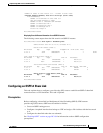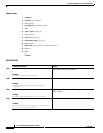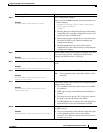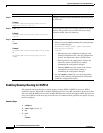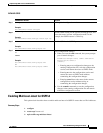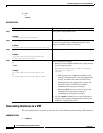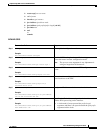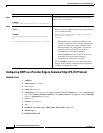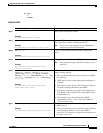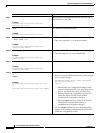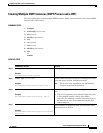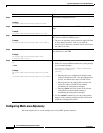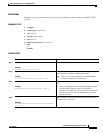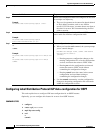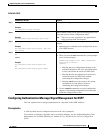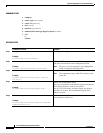
Implementing OSPF on Cisco IOS XR Software
How to Implement OSPF on Cisco IOS XR Software
RC-241
Cisco IOS XR Routing Configuration Guide
OL-14356-01
12. end
or
commit
DETAILED STEPS
Command or Action Purpose
Step 1
configure
Example:
RP/0/RP0/CPU0:router# configure
Enters global configuration mode.
Step 2
router ospf process-name
Example:
RP/0/RP0/CPU0:router(config)# router ospf 1
Enables OSPF routing for the specified routing process and
places the router in router configuration mode.
Note The process-name argument is any alphanumeric
string no longer than 40 characters.
Step 3
vrf vrf-name
Example:
RP/0/RP0/CPU0:router(config-ospf)# vrf vrf1
Creates a VRF instance and enters VRF configuration
mode.
Step 4
router-id {router-id}
Example:
RP/0/RP0/CPU0:router(config-ospf-vrf)#
router-id 192.168.4.3
Configures a router ID for the OSPF process.
Note We recommend using a stable IPv4 address as the
router ID.
Step 5
redistribute protocol [process-id] {level-1 |
level-1-2 | level-2} [metric metric-value]
[metric-type type-value] [match {internal |
external [{1 | 2} | nssa-external {1 | 2}] [tag
tag-value] [route-map map-tag | route-policy
policy-tag]
Example:
RP/0/RP0/CPU0:router(config-ospf-vrf)#
redistribute bgp 1 level-1
Redistributes OSPF routes from one routing domain to
another routing domain.
• This command causes the router to become an ASBR
by definition.
• OSPF tags all routes learned through redistribution as
external.
• The protocol and its process ID, if it has one, indicate
the protocol being redistributed into OSPF.
• The metric is the cost you assign to the external route.
The default is 20 for all protocols except BGP, whose
default metric is 1.
• The example shows the redistribution of BGP
autonomous system 1, Level 1 routes into OSPF as
Type 2 external routes.
Step 6
area area-id
Example:
RP/0/RP0/CPU0:router(config-ospf-vrf)# area 0
Enters area configuration mode and configures an area for
the OSPF process.
• The area-id argument can be entered in dotted-decimal
or IPv4 address notation, such as area 1000 or
area 0.0.3.232. However, you must choose one form or
the other for an area.



